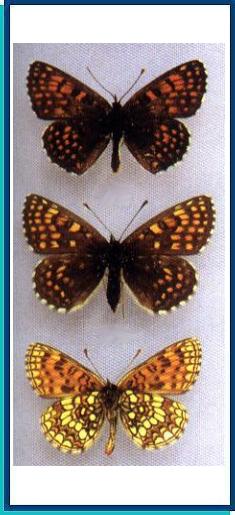LEPIDOPTERA
N Y M P H A L I D A E Swainson, 1827
MELLICTA Billberg, 1820
Mellicta britomartis (Assmann, 1847)
Mellicta britomartis (Assmann, 1847)

• TYPE LOCALITY. Breslau [Wroclaw, Poland].
• RANGE. From central Europe across the S. European part, N. Kazakhstan, the Altais and S. Siberia to NE. China and Korea.
• DISTRIBUTION AND VARIATION. Both individual and georgaphical variation being great, it is difficult to divide this taxon into subspecies. Here we follow the opinion of Higgins (1955) and split britomartis into two subspecies: the nominotypical one (= veronicae Dorfmeister, 1853; = marussia Fruhstorfer, 1919), which occupies the western part of the distribution area to the Altais in the east, and the ssp. amwensis Staudinger, 1892 (= seminigra Seitz, [1909]; = imitans Verity, 1930; = frigidaltaica Verity, 1940), ranging from the Altais to the Pacific coast. Populations of both subspecies meet in the Altai Mts., this being apparently regardless of altitudinal and ecological conditions. Some specimens from the S. Ussuri region are transitional toward the ssp. latefascia Fixsen, 1883 (= coreae Verity, 1930).
• TAXONOMIC NOTES. The present subspecific arrangement is by no means to be regarded as final. Further studies based on accumulation of new material and field observations are required to refine the status and distribution of the known forms. That more than one species is involved, cannot be excluded.
• HABITATS AND BIOLOGY. Forest edges and clearings and other flowering places in the forest-steppe and steppe belts, also in the mountains up to 2,400 m a.s.l. Usually sharing the habitats with M. athalia, M. aurelia and M. centralasiae. Flight period: June to July. Host plants (Kumakov & Korshunov, 1979; Tolman, 1997): Plantago, Veronica, Rhinanthus, Linaria uulgaris. Besides that, larvae have been found on Melampyrum, Chrysantemum, etc. Hibernation larval (Kumakov & Korshunov. 1979).
• SIMILAR SPECIES. Mellicta aurelia, M. centralasiae: UPS generally less suffused with black; pale apical spots of UNF extended; UNH double marginal line of same colour as submarginal spots. M. athalia, M. ambigua: generally larger and brighter, marking of UPS less regular (except for M. athalia reticulata; UNH postdiscal fascia without dark shading. M. diamina: UPS usually more suffused (especially UPH); dark spots in submarginal fascia of UNH well-developed.
Photo and text: Guide to the BUTTERFLIES OF RUSSIA and adjacent territories Volume 2. PENSOFT, Sofia - Moscow. 2000